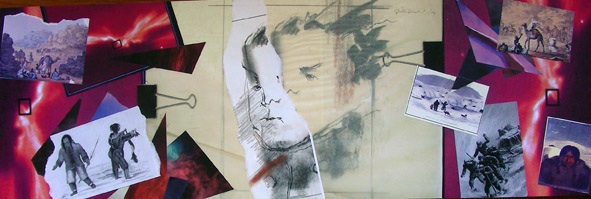 |
|
George F. Lyon:
Sketching from Tripoli to Repulse Bay
George Francis Lyon (1795–1832)
British naval explorer of the Arctic and the Sahara, artist, socialite.
George Francis Lyon was a rare combination of Arctic and African explorer. By all accounts a fun loving extrovert, he also managed to be a competent British Naval Officer, Commander, explorer, artist and socialite. While not having a particularly distinguished career, he is remembered for the entertaining journals he kept and for the watercolor paintings he created in Africa and the Arctic.
In 1818 he was sent with Joseph Ritchie by Sir John Barrow to find the course of the River Niger and the location of Timbuktu. The expedition, consisting of two members, was under funded and lacked support. Because of the ideas of John Barrow they departed from Tripoli and thus had to cross the Sahara as part of their journey. A year later, due to much officialdom they had only got as far as Murzouk where they both fell ill. Ritchie died there. Lyon survived and traveled a little further around the region. Exactly a year to the day he left, he arrived back in Tripoli. The expedition was a complete failure except for the visually dramatic sketches and watercolor paintings created by Lyon.
Having been promised a promotion on his return, he now set about trying to pester the Admiralty into fulfilling their promise. He irritated enough people that his reward was, in 1821, to be given the command of HMS Hecla under William Edward Parry on his second attempt at the Northwest Passage.
An aspect of his personality, rare at the time, was his genuine interest in the native culture of the places he visited. Wearing Arab dress and learning fluent Arabic he managed to blend in with the inhabitants of North Africa. He was tattooed by the Inuit in the Arctic, using needle and sooty thread, and ate raw reindeer and seal meat with them. The expedition achieved little, spending two years in the Arctic and getting only as far the Fury and Hecla Straight before being stopped by ice.
Lyon received his promotion to Captain on his return, and in 1824 was given sole command of HMS Griper for another voyage to the Arctic. Unfortunately the Griper was poorly constructed and Lyon also met with some of the worst weather yet seen in the Arctic. The expedition was a disaster, Lyon limping home after only 5 months.
While he was well known in society, this last failure effectively saw him blacklisted in the Navy. He never had another command. He died on Oct 8, 1832 en-route from South America to Britain to be treated for eye problems. His sketches and paintings survive him. They elegantly portray life in very diverse areas of the world.